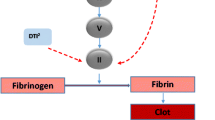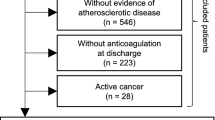Abstract
The combined use of aspirin and oral anticoagulant therapy in patients with atrial fibrillation (AF) and stable coronary artery disease (CAD) has been questioned due to an increased risk of major bleeding with little to no benefit in preventing ischemic events. (1) To better understand patterns and indications for combined antiplatelet and anticoagulant therapy and identify patients who might reasonably be treated with oral anticoagulant (OAC) therapy alone. (2) To perform an updated literature review regarding the use of combined antiplatelet and OAC therapy in patients with AF and stable CAD. Retrospective review. Patients within the University of Cincinnati Health System with a diagnosis of non-valvular AF, excluding those with acute coronary syndrome or revascularization within the last 12 months. Numbers and indications for combined antiplatelet and anticoagulant therapy and sequence of events leading to the initiation of each. Of 948 patients receiving OAC, 430 (45 %) were receiving concomitant OAC and aspirin. Among patients receiving combined antiplatelet and anticoagulant therapy, 49 and 42 % of patients respectively, had CAD or DM. In a more detailed analysis including chart review of 219 patients receiving combined OAC and aspirin, 27 % had a diagnosis of CAD and 14 % had a diagnosis of DM prior to the development of AF. These patients were initially treated with aspirin. Warfarin was added when they subsequently developed AF but aspirin wasn’t discontinued. A surprisingly large proportion of patients (22.8 %) had no obvious indication for dual therapy. Prior myocardial infarction, CAD, vascular disease and DM (among others) increase the likelihood of receiving combined antiplatelet and anticoagulant therapy among patients with AF. A literature review suggests this may lead to increased major bleeding with little benefit in decreasing either AF-related stroke or cardiovascular events.


Similar content being viewed by others
References
Go AS, Hylek EM, Phillips KA et al (2001) Prevalence of diagnosed atrial fibrillation in adults: national implications for rhythm management and stroke prevention: the AnTicoagulation and risk factors in atrial fibrillation (ATRIA) study. Jama 285:2370–2375
Dentali F, Douketis JD, Lim W, Crowther M (2007) Combined aspirin-oral anticoagulant therapy compared with oral anticoagulant therapy alone among patients at risk for cardiovascular disease: a meta-analysis of randomized trials. Arch Intern Med 167:117–124
Dewilde WJ, Oirbans T, Verheugt FW et al (2013) Use of clopidogrel with or without aspirin in patients taking oral anticoagulant therapy and undergoing percutaneous coronary intervention: an open-label, randomised, controlled trial. Lancet 381:1107–1115
Flaker GC, Gruber M, Connolly SJ et al (2006) Risks and benefits of combining aspirin with anticoagulant therapy in patients with atrial fibrillation: an exploratory analysis of stroke prevention using an oral thrombin inhibitor in atrial fibrillation (SPORTIF) trials. Am Heart J 152:967–973
Hansen ML, Sorensen R, Clausen MT et al (2010) Risk of bleeding with single, dual, or triple therapy with warfarin, aspirin, and clopidogrel in patients with atrial fibrillation. Arch Intern Med 170:1433–1441
Lamberts M, Gislason GH, Lip GY et al (2014) Antiplatelet therapy for stable coronary artery disease in atrial fibrillation patients taking an oral anticoagulant: a nationwide cohort study. Circulation 129:1577–1585
Steinberg BA, Kim S, Piccini JP et al (2013) Use and associated risks of concomitant aspirin therapy with oral anticoagulation in patients with atrial fibrillation: insights from the outcomes registry for better informed treatment of atrial fibrillation (ORBIT-AF) Registry. Circulation 128:721–728
Hamon M, Lemesle G, Tricot O et al (2014) Incidence, source, determinants, and prognostic impact of major bleeding in outpatients with stable coronary artery disease. J Am Coll Cardiol 64:1430–1436
You JJ, Singer DE, Howard PA et al (2012) Antithrombotic therapy for atrial fibrillation: antithrombotic therapy and prevention of thrombosis, 9th ed: American College of Chest Physicians Evidence-Based Clinical Practice Guidelines. Chest 141:e531S–e575S
Standards of Medical Care in Diabetes (2016) Summary of revisions. Diabetes Care 39 Suppl 1:S4–S5
Lip GY, Nieuwlaat R, Pisters R, Lane DA, Crijns HJ (2010) Refining clinical risk stratification for predicting stroke and thromboembolism in atrial fibrillation using a novel risk factor-based approach: the euro heart survey on atrial fibrillation. Chest 137:263–272
Pisters R, Lane DA, Nieuwlaat R, de Vos CB, Crijns HJ, Lip GY (2011) A novel user-friendly score (HAS-BLED) to assess 1-year risk of major bleeding in patients with atrial fibrillation: the Euro Heart Survey. Chest 138:1093–1100
Guyatt GH, Norris SL, Schulman S et al (2012) Methodology for the development of antithrombotic therapy and prevention of thrombosis guidelines: antithrombotic therapy and prevention of thrombosis, 9th ed: American College of Chest Physicians Evidence-Based Clinical Practice Guidelines. Chest 141:53S–70S
Dentali F, Douketis JD, Gianni M, Lim W, Crowther MA (2007) Meta-analysis: anticoagulant prophylaxis to prevent symptomatic venous thromboembolism in hospitalized medical patients. Ann Intern Med 146:278–288
Avezum A, Lopes RD, Schulte PJ et al (2015) Apixaban compared with warfarin in patients with atrial fibrillation and valvular heart disease: findings from the ARISTOTLE trial. Circulation 132:624–632
Flaker G, Ezekowitz M, Yusuf S et al (2012) Efficacy and safety of dabigatran compared to warfarin in patients with paroxysmal, persistent, and permanent atrial fibrillation: results from the RE-LY (randomized evaluation of long-term anticoagulation therapy) study. J Am Coll Cardiol 59:854–855
Wolff T, Miller T, Ko S (2009) Aspirin for the primary prevention of cardiovascular events: an update of the evidence for the U.S. preventive services task force. Ann Intern Med 150:405–410
Fihn SD, Gardin JM, Abrams J et al (2012) ACCF/AHA/ACP/AATS/PCNA/SCAI/STS Guideline for the diagnosis and management of patients with stable ischemic heart disease: a report of the American College of Cardiology Foundation/American Heart Association Task Force on Practice Guidelines, and the American College of Physicians, American Association for Thoracic Surgery, Preventive Cardiovascular Nurses Association, Society for Cardiovascular Angiography and Interventions, and Society of Thoracic Surgeons. J Am Coll Cardiol 60:e44–e164
Levine GN, Bates ER, Blankenship JC et al (2011) ACCF/AHA/SCAI guideline for percutaneous coronary intervention: a report of the American College of Cardiology Foundation/American Heart Association Task Force on Practice Guidelines and the Society for Cardiovascular Angiography and Interventions. Catheter Cardiovasc Interv 82:E266–355
Camm AJ, Lip GY, De Caterina R et al (2012) 2012 focused update of the ESC Guidelines for the management of atrial fibrillation: an update of the 2010 ESC Guidelines for the management of atrial fibrillation. Developed with the special contribution of the European Heart Rhythm Association. Eur Heart J 33:2719–2747
Marcucci M, Lip GY, Nieuwlaat R, Pisters R, Crijns HJ, Iorio A (2014) Stroke and bleeding risk co-distribution in real-world patients with atrial fibrillation: the Euro Heart Survey. Am J Med 127:979–986
Thrombosis prevention trial (1998) Randomised trial of low-intensity oral anticoagulation with warfarin and low-dose aspirin in the primary prevention of ischaemic heart disease in men at increased risk. The medical research council’s general practice research framework. Lancet 351:233–241
Hurlen M, Abdelnoor M, Smith P, Erikssen J, Arnesen H (2002) Warfarin, aspirin, or both after myocardial infarction. N Engl J Med 347:969–974
Cairns JA, McMurtry MS (2013) Oral antithrombotic therapy in atrial fibrillation associated with acute or chronic coronary artery disease. Can J Cardiol 29:S60–S70
Lane DA, Raichand S, Moore D et al (2013) Combined anticoagulation and antiplatelet therapy for high-risk patients with atrial fibrillation: a systematic review. Health Technol Assess 17:1–188
Funding
Support for this study came from the Pfizer Educational Group, Bristol-Myers Squibb/Pfizer Education Consortium, and NIH/NCATS grant 8 UL1 TR000077-05. The funding sources had no role in study design, data collection, data analysis, data interpretation, or writing of the manuscript. The corresponding author had full access to all the data in the study and had final responsibility for the decision to submit for publication.
Author contributions
MHE was responsible for the conception and design of the project; MHE, and CS were responsible for acquisition of data; MHE and CS were responsible for data analysis and interpretation; SO and MHE drafted the original article and made critical revisions, provided intellectual content, and approved the final draft.
Author information
Authors and Affiliations
Corresponding author
Ethics declarations
Conflict of interest
Mark H. Eckman—has investigator-initiated grant funding from Boehringer-Ingelheim/Heart Rhythm Society, Pfizer Educational Group, Bristol-Myers Squibb/Pfizer Education Consortium, and NIH/NCATS Grant 8 UL1 TR000077-05, and the Cystic Fibrosis Foundation. Charlotte H. So—has no conflicts of interest.
Electronic supplementary material
Below is the link to the electronic supplementary material.
Rights and permissions
About this article
Cite this article
So, C.H., Eckman, M.H. Combined aspirin and anticoagulant therapy in patients with atrial fibrillation. J Thromb Thrombolysis 43, 7–17 (2017). https://doi.org/10.1007/s11239-016-1425-5
Published:
Issue Date:
DOI: https://doi.org/10.1007/s11239-016-1425-5




